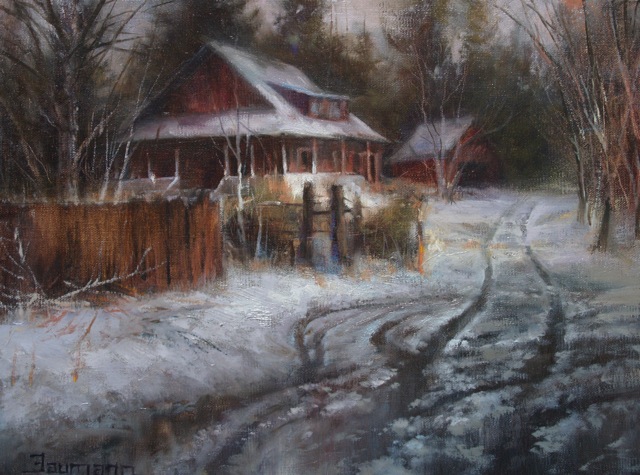“Slushy Streets” by Stefan Baumann
Even though it is winter at The Grand View Ranch, it has been very dry and everyone is waiting with great anticipation for it to snow. There is something about winter that makes me want to put on my warm coat, boots, pack a flask of rum in my painting box (just to take the chill off of Old Jack Frost), and step outside where it’s 32 degrees to paint.
I painted this sketch in the beginning of December when we had a brief and wet snowstorm. I love to paint wet slushy streets where tire marks can be seen in the snow. It tells a story of something that has happened in a very brief moment, and then disappears. It is important to learn how to paint what you love. When I paint wet streets, I first apply my paint in a vertical manner using Cobalt blue and Asphaltum in a thin transparent manner altering the blue and brown colors to create the interesting patterns in the wet street. Then I place in the dabs of snow by starting with the darker spots and adding lighter values as I sculpt the effect of the tire ruts. The color of the snow is painted with the same colors that I used to create the wet pavement. The effect of light behind the fence creates a beautiful contrast to what could have been an overall gloomy day.
Many students ask what they should paint and I ask them, “What do you LOVE?” It is surprising how many artists paint by looking at things and paint what they see. Few artists really ask themselves, “What do I see that I love about this scene?” Do I love the summer light on an early morning city street or the warm feeling of a balmy afternoon sun reflecting on a lake? Connecting personally and emotionally with your subject is the first step to creating paintings that communicate your message to the viewer.
When you paint what you love, thoughtfully consider what you think and feel about the subject that you want to share with someone as you create your painting. Do you love the light, the colors, the patterns that are created, the shadows, or how cool or warm it feels? Is it the mood of the scene, or the story that is told? By focusing on your response to what you love, you will connect with your inner artist and develop a style of your own. The next time you are out on location, take time to evaluate what inspires you or what touches your heart about the subject, and then communicate that idea or feeling to the viewer as you paint. Painting from life is an act of connecting within yourself to your own sense of wonder and beauty so that you can have something extraordinary to say to others through your paintings.
____________________________________________________
Plein air and Alla Prima artist Stefan Baumann, host of the PBS painting series “The Grand View, America’s National Park through the eyes of an artist” and author of “Observations Of Art and Nature,” travels in his vintage travel trailer painting America’s western landscape. Baumann paints outdoors with oils and canvas capturing stunning vistas, wildlife, western landscapes, National Parks and still life, thrilling art collectors throughout the world. He has many collectors acquiring his paintings as investment internationally. His painting style is called Romantic Realism with Lumunism and the extraordinary way he captures the effect of light is a truly an American Style used to paint the Western Landscape. He can be seen painting in Yellowstone, Yosemite and in the Grand Canyon and Baumann’s “how to paint” DVDs filmed on location in the National Parks are the very best on the market.

